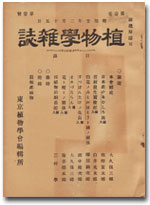All issues

Volume 51, Issue 611
Displaying 1-12 of 12 articles from this issue
- |<
- <
- 1
- >
- >|
-
1937 Volume 51 Issue 611 Pages Cover_611-
Published: 1937
Released on J-STAGE: March 03, 2023
JOURNAL FREE ACCESSDownload PDF (692K) -
Morus in Cultivation. VTeikichi Hotta1937 Volume 51 Issue 611 Pages 833-838
Published: 1937
Released on J-STAGE: May 24, 2007
JOURNAL FREE ACCESSDownload PDF (835K) -
Hiroshi Hara1937 Volume 51 Issue 611 Pages 838-846
Published: 1937
Released on J-STAGE: May 24, 2007
JOURNAL FREE ACCESSDownload PDF (4287K) -
Morisige Harada1937 Volume 51 Issue 611 Pages 846-856
Published: 1937
Released on J-STAGE: May 24, 2007
JOURNAL FREE ACCESS1. The stem of a seedling has only 4 resin canals in the phloem but none in the pith. On the contrary, the very young stem which has sprouted from the bud has a great many resin canals in both the phloem and the pith. Those in the phloem run parallel to the vascular bundles in any part, ending blindly. The resin canals in the pith sometimes make a net work, especially when they appear in buds. The number of the resin canals in the outer portion of the bast of old stems diminishes gradually and their shape is somewhat oval in the cross section, and the neighbouring cells of their epithel increase the thickness of the cell membrane in some degree. On the other hand, many smaller resin canals which are almost circularly formed in the cross section appear in the secondary portion of the bast.
2. There are only 2 resin canals in the petiole of the cotyledon, but 4 in the petiole of the leaflets of the seedling, and only one in the lateral veins and veinlets. The petiole and midrib of a well developed leaf has 4 large resin canals and additional smaller ones, but only one in the distal portion of the midrib, in the lateral veins and veinlets.
3. There are 4 resin canals in the very young root. The 3-4 years old root has 4-6 resin canals in the primary portion of the bast, and moreover 10-20 resin canals in its secondary portion which are arranged almost circularly in one or two rows. The resin canals in the primary and the secondary portion in the bast of the very old main root are however distributed irregularly and in different sizes in the cross section.
4. The sepals and petals have a large vascular bundle as a midrib running towards the distal portion from the base, which is accompanied by a large resin canal in its phloem. In each of the vascular bundle, branching off from it on both sides, we find also a resin canal.
5. There are a great number of small and large resin canals in the mesocarp of the fruit, which run parallel with one another from the base of the fruit stalk to the style rest. They increase their number with the development of the fruit. The first stage of the resin canal may be clearly observed in the mesocarp of fruits. The groups of special cells in the mesocarp of a very young fruit forms at first schizogenously a very small resin canal, which becomes larger and larger lysigenously according as the fruit develops. These resin canals in this part are surrounded by a parenchyma sheath as the fruit develops by and by, and vascular bundles are arranged in a circle around this sheath.View full abstractDownload PDF (1123K) -
Masazi Honda1937 Volume 51 Issue 611 Pages 857-859
Published: 1937
Released on J-STAGE: May 24, 2007
JOURNAL FREE ACCESSDownload PDF (169K) -
VII. Geschlechtschromosomen bei einigen Arten von Gattung MarchantiaSEIZI TATUNO1937 Volume 51 Issue 611 Pages 860-866
Published: 1937
Released on J-STAGE: May 24, 2007
JOURNAL FREE ACCESSZum Studium der Geschlechtschromosomen habe ich in der vorliegenden Arbeit 5 diözische Arten von Marchantia, nämlich M. polymorpha, M. diptera, M. radiata, M. tosana und M. cuneiloba untersucht.
1. Bei M. polymorpha fanden schon HAUPT (1932) und LORBEER (1934) Geschlechtschromosomen. An einer einheimischen Rasse dieser Art konnte ich ihre Beobachtungen bestätigen. Die Chromosomenformel lautet in diesem Falle:
Gametophyt _??_ 8+X _??_ 8+Y
2. Bei M. diptera konnte ich erstmalig Geschlechtschromosomen finden. Ihre Chromosomenformel lautet wie bei M. polymorpha:
Gametophyt _??_ 8+X _??_ 8+Y
3. M. radiata, M. tosana und M. cuneiloba haben je ein Heterochromosom h. Aber das h-Chromosom ist wohl kein Geschlechtschromosom, well sowohl das h-Chromosom wie die anderen Chromosomen des weiblichen Thallus mit denen des männlichen Thallus völlig übereinstimmen. Die 3 Arten haben die Chromosomenformel:
_??_ _??_ 9=8+hView full abstractDownload PDF (569K) -
TEIICHIRO TAKEMOTO1937 Volume 51 Issue 611 Pages 866-871
Published: 1937
Released on J-STAGE: May 24, 2007
JOURNAL FREE ACCESSChrysanthemum lavandulaefolium hat 9 gametische Chromosomen, Chrysanthemnm indicum hingegen 18. Der F1-Bastard dieser beiden Arten hat, wie erwartet, 27 zygotische Chromosomen und steht im Aussehen zwischen den Elternpflanzen (Fig. 1 u. 2).
Die 27 Chromosomen, die aus einer Kernplatte aus der Wurzelspitze dieses Bastards genommen werden, können, wie Fig. 4 zeigt, in 3 beinahe homologen Sätzen angeordnet werden.
Entsprechend dieser Tatsache treten trivalente Chromosomen in der heterotypischen Metaphase in P.M.Z. des Bastards auf.View full abstractDownload PDF (651K) -
Observations on the Purple and Green Bacteria in a Sulphur Spring at Yumoto, NikkoTadao Jimbo1937 Volume 51 Issue 611 Pages 872-874
Published: 1937
Released on J-STAGE: March 03, 2023
JOURNAL FREE ACCESSDownload PDF (212K) -
1937 Volume 51 Issue 611 Pages 874-877
Published: 1937
Released on J-STAGE: March 03, 2023
JOURNAL FREE ACCESSDownload PDF (281K) -
1937 Volume 51 Issue 611 Pages 877-890
Published: 1937
Released on J-STAGE: March 03, 2023
JOURNAL FREE ACCESSDownload PDF (1372K) -
1937 Volume 51 Issue 611 Pages App39-App40
Published: 1937
Released on J-STAGE: March 03, 2023
JOURNAL FREE ACCESSDownload PDF (152K) -
1937 Volume 51 Issue 611 Pages Cover_611b-
Published: 1937
Released on J-STAGE: March 03, 2023
JOURNAL FREE ACCESSDownload PDF (922K)
- |<
- <
- 1
- >
- >|